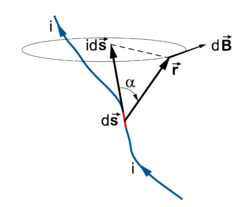Biot-Savart law
In physics, more particularly in electrodynamics, the law first formulated by Jean-Baptiste Biot and Félix Savart [1] describes the magnetic field caused by a direct electric current in a wire. Biot and Savart interpreted their measurements by an integral relation. Laplace gave a differential form of their result, which now often is also referred to as the Biot-Savart law, or sometimes as the Biot-Savart-Laplace law. By integrating Laplace's equation over an infinitely long wire, the original integral form of Biot and Savart is obtained.
Laplace's formula
The infinitesimal magnetic induction dB at point r is given by the following formula due to Laplace,
where the magnetic induction is given as a vector product, i.e., is perpendicular to the plane spanned by ds and r. The constant k depends on the units chosen. In rationalized SI units k is the magnetic constant (vacuum permeability) μ0 = 4π ×10−7 N/A2 (newton divided by ampere squared). If we think of the fact that the vector r has dimension length, we see that this equation is an inverse distance squared law.
(To be continued)
References
- ↑ J.-B. Biot and F. Savart, Note sur le Magnétisme de la pile de Volta, Annales Chim. Phys. vol. 15, pp. 222-223 (1820)

